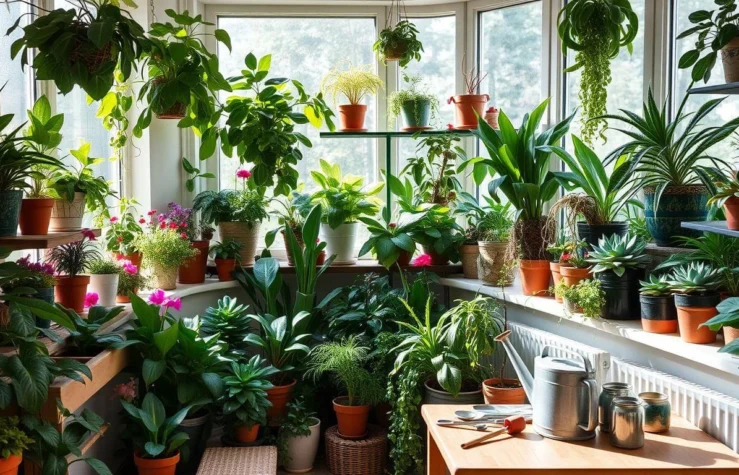Turning your home into a green oasis is now easy and popular in cities across the U.S. The indoor gardening hobby lets you create your own paradise at home. It’s a growing trend for sustainable living and personal ecosystems.
Indoor gardening boosts air quality and mental health, as studies by NASA and the Environmental Protection Agency show. It also offers a creative outlet, bringing joy and peace. We’ll share key indoor gardening tips to help you start your own green space at home.
Introduction to Indoor Gardening
Indoor gardening has become very popular in recent years. It’s a hobby that many people enjoy to make their homes look better. It also helps improve mental health and lower stress. By bringing nature inside, indoor gardening makes spaces more lively. Indoor gardening can uplift your mood and enhance your productivity. Anyone can start growing plants indoors, no matter where they live.
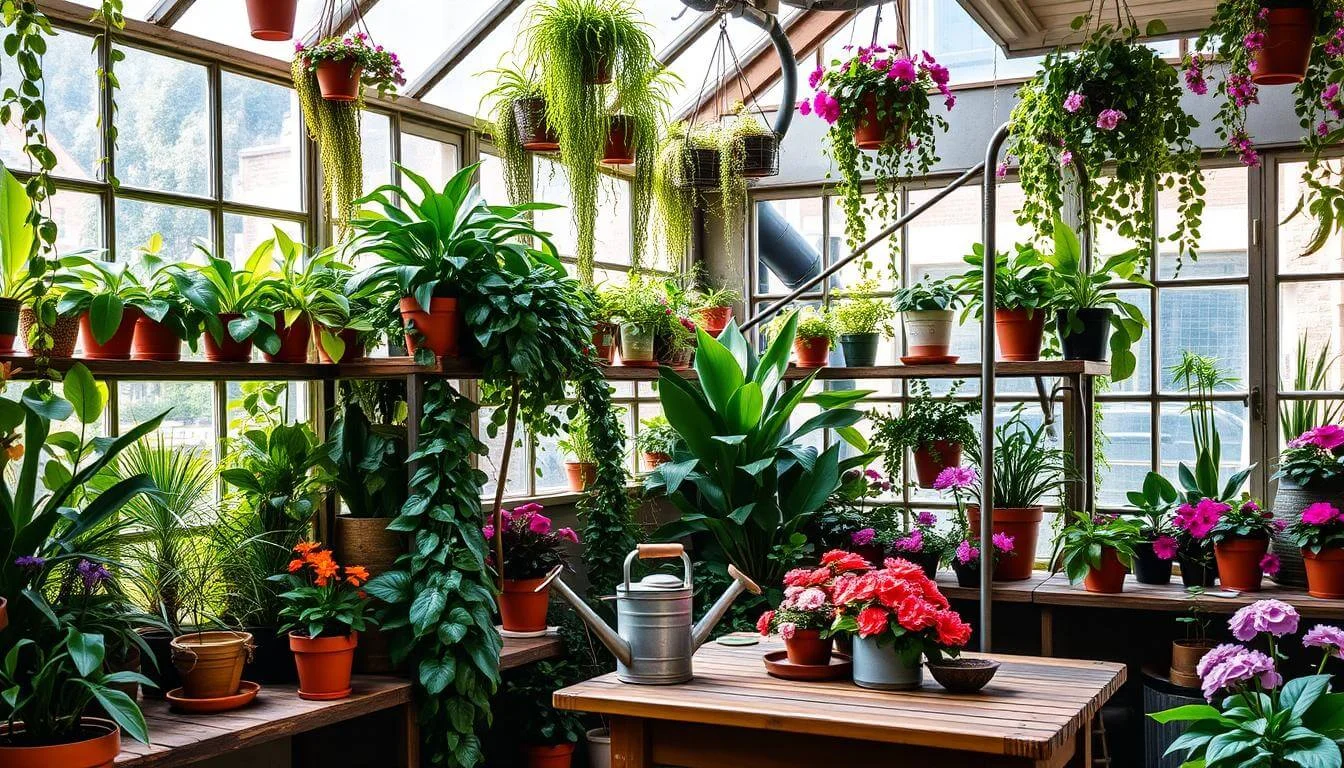
Starting with indoor gardening is easy and doesn’t cost much. You just need to pick simple plants and use your space well. As you care for your plants, you’ll feel more connected and emotionally richer.
- Enhances mental well-being
- Reduces stress and anxiety
- Improves air quality
- Accessible to all skill levels
- Encourages responsibility and mindfulness
| Benefit | Description |
|---|---|
| Mental Health | Indoor gardening has been linked to reduced anxiety and improved mood. |
| Aesthetic Value | Plants enhance the beauty and livability of indoor spaces. |
| Environmental Impact | Plants contribute to better air quality by absorbing toxins. |
| Accessibility | Easily adaptable to various living conditions and skill levels. |
| Mindfulness | Engaging with plants encourages a mindful and caring outlook on life. |
Understanding the Indoor Gardening Hobby
Indoor gardening mixes creativity with nature in your home. It lets people grow many plants, making small areas green. To get into indoor gardening, you need to know about different ways to plant, the tools available, and which plants do well indoors. You can use small pots, vertical gardens, or big containers, making it fit any space or lifestyle.
What is Indoor Gardening?
Indoor gardening is about growing plants inside for looks, food, or to clean the air. It can be simple, like having houseplants, or complex, with herbs, veggies, and flowers. You can pick plants that fit your needs, making your home better. As you learn more about indoor gardening, you’ll see how it can be tailored to your taste and creativity.
Benefits of Starting an Indoor Garden
Indoor gardening is good for your body and mind. It offers:
- Fresh Herbs and Vegetables: Growing your own food makes meals taste better and healthier.
- Improved Air Quality: Plants inside help clean the air, making your home healthier.
- Enhanced Home Décor: Plants make your home look better, creating a peaceful feel in any room.
- Stress Relief: Taking care of plants helps you relax and focus, reducing stress.
Best Plants for Indoor Gardening
Choosing the right plants is key for a great indoor garden. The best plants not only look good but also need little care. They’re perfect for both beginners and experienced gardeners. This section focuses on plants that need little light and those that bloom beautifully indoors.
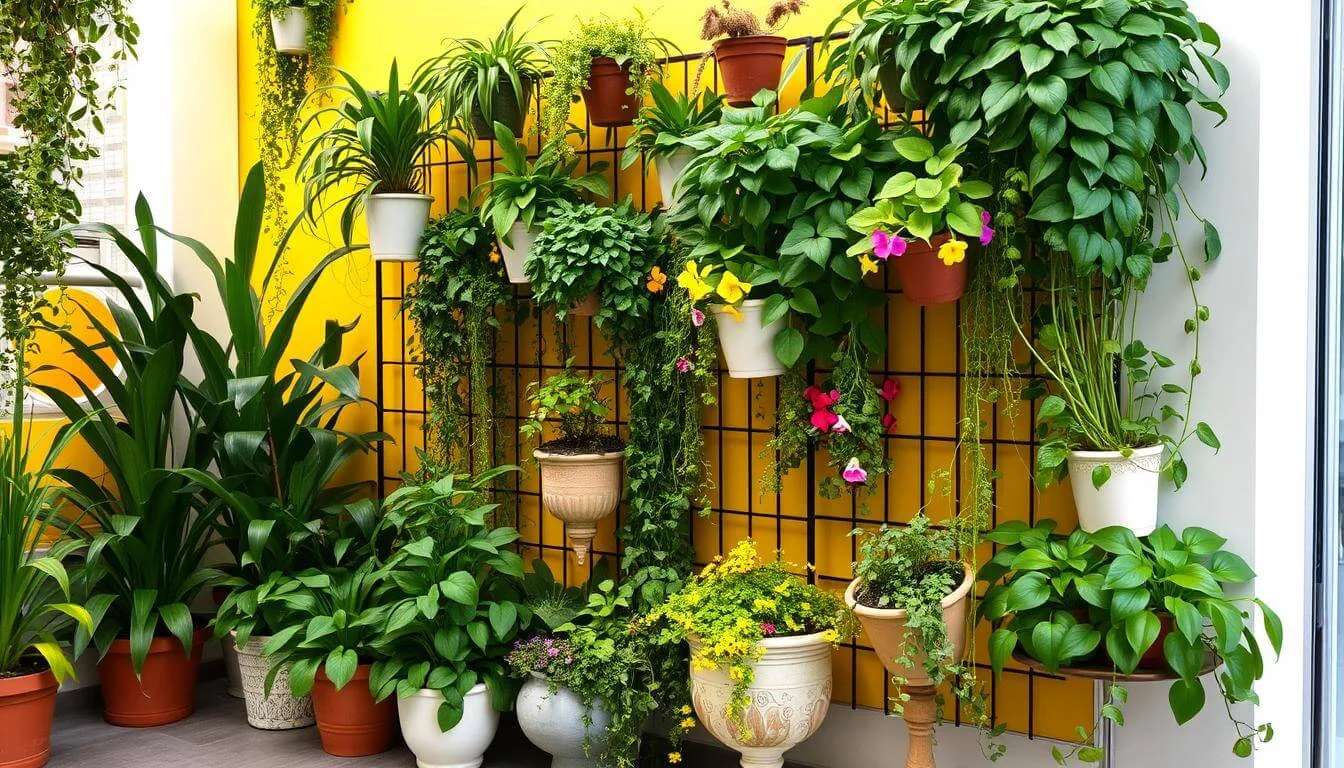
Low-Light Plants for Beginners
Low-light plants are great for starting your indoor garden. They do well in places with not much natural light. This makes them perfect for homes with limited sunlight.
- Snake Plant: Known for its upright growth and striking appearance, the Snake Plant is incredibly resilient and can withstand neglect.
- Pothos: This trailing vine brings a touch of green to any room and can thrive in a variety of lighting conditions.
- ZZ Plant: With glossy leaves and a robust structure, the ZZ Plant is another fantastic choice for low-light spaces.
Flowering Indoor Plants
For a colorful indoor garden, consider flowering plants. These plants brighten your space and make it welcoming.
- African Violets: These small, charming plants feature vibrant blooms and thrive with moderate light and humidity.
- Peace Lily: With its elegant white flowers and lush leaves, the Peace Lily is not only beautiful but also helps purify the air.
- Orchids: Known for their exotic beauty, orchids can add sophistication to your indoor garden with the right attention and care.
Indoor Gardening Tips for Successful Growth
Starting an indoor garden? Knowing how to water and what light plants need is key. These tips will help your plants grow well and make gardening fun.
Watering Techniques
Effective watering is crucial for indoor plants. Too much water can harm them. Here are some tips to help you avoid overwatering:
- Test Soil Moisture: Before watering, press your finger about an inch deep into the soil. If it feels dry to the touch, it’s a good time to give your plant a drink.
- Choose Pots with Drainage: Select pots with drainage holes to ensure excess water flows out, preventing roots from becoming waterlogged.
- Tailor Watering to Each Plant’s Needs: Recognize that plants have different moisture preferences—some thrive in consistently moist soil, while others prefer drier conditions.
Light Requirements for Different Plants
Knowing what light plants need is also vital. Each plant has its own light needs. Here are some tips:
- Identify whether your plants require low, medium, or bright indirect light. This will guide you in placing them appropriately.
- Plants should be rotated occasionally to guarantee that all sides receive enough light. This will promote balanced growth.
- In situations where natural light is limited, consider using grow lights to supplement the light needs of your plants.
| Plant Type | Watering Frequency | Light Requirement |
|---|---|---|
| Snake Plant | Every 2-3 weeks | Low to bright indirect light |
| Pothos | Once a week | Low to bright indirect light |
| Peace Lily | Once a week | Medium to bright indirect light |
Indoor Gardening Supplies You’ll Need
Starting your indoor garden needs the right supplies for your plants to grow well. Knowing the essential tools and the best soil and fertilizers is key. This guide will help you set up a green oasis in your home.
Essential Tools and Equipment
The right tools make indoor gardening easier. Here’s a list of must-haves for all gardeners:
- Pruning Shears: Great for cutting and shaping plants.
- Watering Can: Essential for watering without too much.
- Grow Lights: Needed for plants that don’t get enough natural light.
- Plant Labels: Useful for identifying different plants and their needs.
- Soil Knife: Perfect for digging and aerating soil.
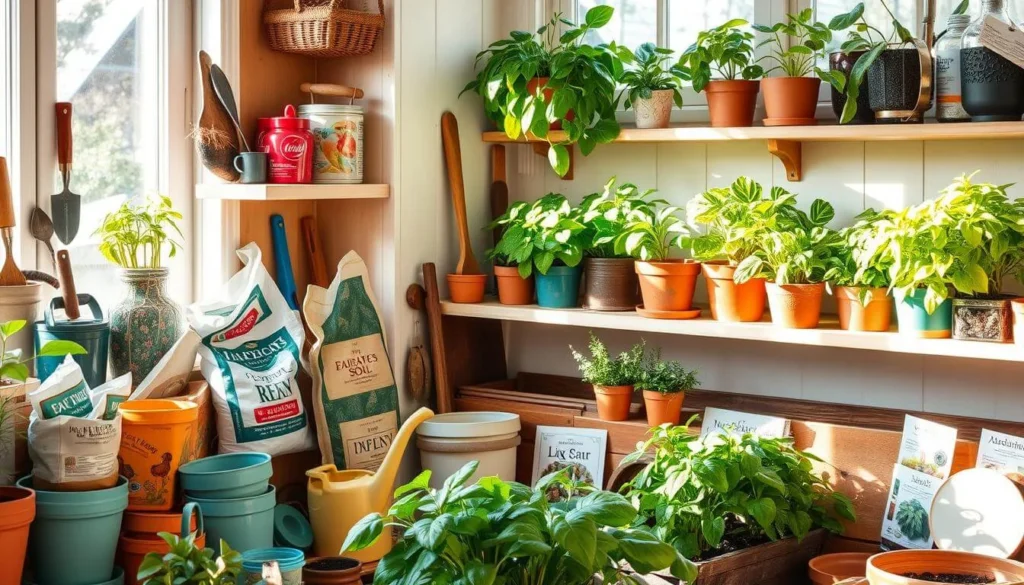
Choosing the Right Soil and Fertilizers
The soil and fertilizers are the base of your garden. Choosing the right soil and fertilizers for indoor plants is crucial. Consider these when picking:
- Potting Mix: Choose a mix that fits your plants’ needs. There are mixes for cacti, orchids, and more.
- Organic Fertilizers: Opt for organic options like compost and worm castings to avoid chemicals.
- Liquid Fertilizers: These mix easily with water for quick nutrient delivery.
- Slow-Release Fertilizers: Good for steady nutrient supply, so you don’t have to feed plants often.
Indoor Gardening Ideas to Transform Your Space
Turning your living space into a green oasis is easy with creative indoor gardening ideas. Vertical gardens are a great way to use small spaces and bring nature indoors. They can be set up on walls or in freestanding units, ideal for tiny homes or apartments.
Creating a Vertical Garden
Vertical gardens are not just pretty; they also improve indoor air quality. You can try a DIY pallet garden or use modular wall planters for a variety of plants. These gardens are versatile, perfect for climbing plants or herbs. For the best results, make sure your plants get the right light and water. This will help them thrive in their new home.
Decorative Planters and Arrangements
The planters you choose are key to your indoor garden’s look. Pick unique materials like ceramic, terracotta, or recycled items for a personal touch. Mixing different plant sizes and textures adds interest. Place your plants on shelves, windowsills, or tables to show them off. This creates a lively and inviting space.
Indoor Gardening for Beginners: A Step-by-Step Guide
Starting an indoor garden is exciting and rewarding. This guide is for those new to indoor gardening. It focuses on easy plants that grow well indoors. Follow these steps to start your indoor gardening journey.
Getting Started with Easy-to-Grow Plants
Choosing the right plants is key for a successful indoor garden. Here are some great options:
- Spider Plant: Known for its air-purifying qualities and resilience.
- Pothos: Thrives in various light conditions, making it ideal for beginners.
- Herbs: Culinary favorites like basil and thyme are rewarding and easy to maintain.
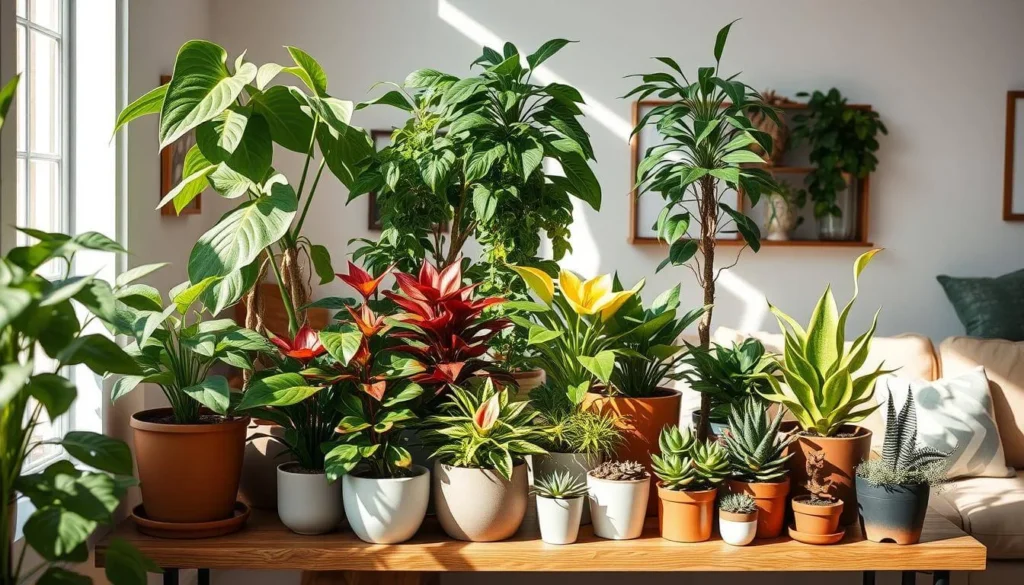
Setting Up Your Indoor Garden
The layout and pots are crucial for a successful indoor garden. Follow this step-by-step guide to set up your garden:
- Plan Your Space: Determine where your garden will reside, considering light and temperature.
- Select Appropriate Pots: Use pots with drainage holes to prevent overwatering.
- Choose Quality Soil: Opt for potting soil tailored for indoor plants to ensure optimal growth.
- Arrange Your Plants: Position plants according to their light requirements, grouping those with similar needs.
By following these simple steps, beginners can create a thriving indoor garden. Caring for these plants is rewarding and can transform any space.
| Plant Name | Light Requirements | Watering Frequency |
|---|---|---|
| Spider Plant | Indirect light | Once a week |
| Pothos | Low to bright indirect light | Every 1-2 weeks |
| Basil | Bright direct light | Every few days |
Indoor Gardening Techniques for Maximum Yield
To make your indoor gardening better and get more from your plants, you need to learn some key techniques. These include effective ways to start new plants, prune them, and keep them healthy. All these steps can really help your plants grow well and give you more.
Propagation Methods
Using the right ways to start new plants is very important. You can use leaf cuttings, stem cuttings, or division to grow new plants. This way, you can have more of your favorite plants and make your indoor garden look fuller and more interesting.
Pruning and Maintenance Practices
Pruning your plants regularly is key for their health and growth. Knowing how to prune your indoor plants helps them stay the right size and grow bushy. Also, keeping up with a routine maintenance schedule is crucial. This includes checking the water and looking for pests. Doing this will keep your indoor garden looking great for a long time.
Use methods like leaf cuttings or division to grow more plants. Prune plants to keep them healthy. Regular care and watching the environment are key for good growth.
Conclusion
In conclusion, embracing indoor gardening allows you to create a vibrant, green sanctuary right in your home. Not only does it enhance the aesthetic appeal of your space, but it also offers numerous health benefits, from cleaner air to reduced stress. Indoor gardening is accessible to all, regardless of experience or space constraints, making it an ideal hobby for those looking to add a touch of nature to their surroundings.
As you nurture your indoor plants, you’ll find a sense of tranquility and fulfillment in the simple acts of watering, pruning, and watching your plants flourish. Whether you’re cultivating lush foliage or vibrant blooms, indoor gardening is a rewarding journey that transforms any living space into a personal paradise. So go ahead, dig into this green hobby, and let your indoor garden become a source of joy, health, and inspiration every day.
Frequently Asked Questions (FAQs)
What is indoor gardening?
Indoor gardening means growing plants inside homes or buildings. People use pots and containers to make a green space. It can be as simple as herbs on a windowsill or a big setup in a room.
What are the benefits of indoor gardening?
Indoor gardening improves air quality and mental health. It makes homes look better and feel more welcoming. Growing your own food and plants can boost your mood and sense of pride.
What are some good plants for indoor gardening?
Great plants for indoors include Snake Plants, Pothos, and Spider Plants. African Violets and Peace Lilies are also good. They’re easy to care for and can handle different light levels.
What indoor gardening tips should beginners know?
Start by learning how to water plants right. Know what light they need. Choose plants that are easy to grow. Also, learn about the right soil and fertilizers for your plants.
What supplies do I need for indoor gardening?
You’ll need potting soil, containers, and a watering can. Pruning shears and grow lights are also important. These tools help your plants grow well.
How can I design an indoor garden?
Think about using vertical gardens or decorative planters. Plan your space to get the most light. Arrange plants in a way that looks good and fits well.
What techniques are best for maximizing indoor gardening yields?
Use methods like leaf cuttings or division to grow more plants. Prune plants to keep them healthy. Regular care and watching the environment are key for good growth.
Can indoor gardening improve my mental health?
Yes, gardening indoors can lower stress and make you feel calmer. It’s good for your mind and can be a way to practice mindfulness.

